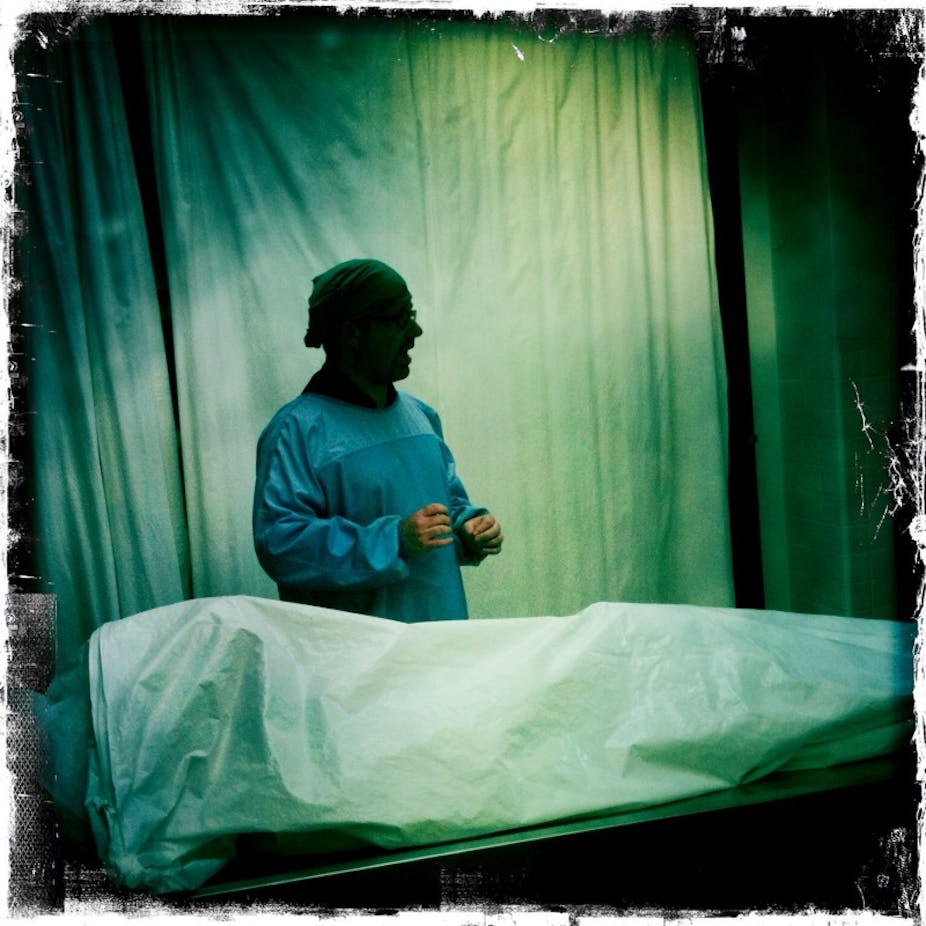You’ve just died. Your family is distraught. Before passing on, you made arrangements to donate your body to your local university for the purpose of scientific training.
Your family and friends respect this wish and, like you, believe in its value. But what happens now? What actually happens to your body?
As with other universities, the University of Melbourne has a donor body program which acquires the bodies of deceased persons for the purposes of anatomical examination and the teaching and study of anatomy.
The use of cadavers or cadaver parts is governed by the Human Tissue Act 1982 (Victoria) and the university is the only accredited program in Victoria for people who wish to donate their remains for this purpose.
Before you go
As a living donor you will have first contacted the Department of Anatomy and Cell Biology directly or by completing access forms on the website. This was a decision made by you, importantly – not your family.
The forms required your signature, not that of a power of attorney, executor or next of kin. You will have received a letter acknowledging receipt of your form and consent and this constitutes a formal agreement between you and the department.
Until you died, it wasn’t a binding agreement: you could have changed your mind at any time by notifying the body donor coordinator at the university, in writing, of your decision.
Now, of course, it’s too late.
We’ve informed your next of kin that we would like to retain your body for a minimum of three years, although in many cases it will be less than this. In some cases the department may choose to retain a tissue sample or selected body part, or parts, indefinitely for teaching purposes.
In some circumstances your body may not be accepted by the university:
- if an autopsy has been performed.
- if there are delays in notifying us of your death.
- if the cause of death is associated with significant disease.
- if death occurs at a distance of more than 60km from Melbourne’s CBD.
Who’s going to pick you up?
After notification of your death, the university-authorised undertakers will collect your body and deliver it to the department. Blood samples are taken and tested for diseases such as HIV and hepatitis and the body donor secretary may contact your doctor and ask whether or not you showed any signs of dementia or whether he/she is aware of significant infectious diseases such as tuberculosis.
Confirmation of any of these will usually result in the department rejecting your body. We will also ask whether or not you spent six months or more in the United Kingdom between the beginning of 1980 and the end of 1996 or had received a blood transfusion in the UK since 1980.
These questions relate to the small number of cases of patients with Creutzfeldt-Jacob Disease (CJD – the human form of “mad cow disease”) who have been infected through blood transfusion. There is also concern that a variant of CJD may be transmitted to humans through consumption of contaminated beef.
Following acceptance, your body will be embalmed – a process in which preserving fluid is injected via a blood vessel in your groin. This fluid permeates your entire body, disinfecting, fixing and moisturising tissues, all of which aids subsequent dissection.
Once embalming is completed, your body will be stored in a refrigerator until the commencement of the next anatomy teaching period (which can be several months later).
Getting to know you
Students will dissect your body in groups of six to eight, focusing on specific parts that correspond with the relevant phases of the teaching program. First they’ll remove surface tissues, including your skin, to reveal deeper structures, such as your muscles, nerves, vessels and internal organs.
They will look for signs of disease that may have contributed to your death and verify their findings against information provided by your doctor in relation to the likely cause of death. The dissection process may continue for several months after which the remains are assembled together and placed into a coffin ready for cremation.
As many as 120 bodies a year are accepted by the University of Melbourne for anatomical examination. There is rarely a risk that students involved in any of our teaching programs will recognise the remains of a family member although in the past students have notified us of their concerns when they know a loved one had died recently and was a member of the body donor program.
In such a case the body will not be used for dissection at the university but may be transferred to another institution.
Following completion of our studies, we will notify your next of kin that your remains have been cremated and that the ashes are available to be collected. If we do not hear from your family within two months the university may make arrangements for your ashes to be scattered or disposed of at its discretion.
At this point, you can rest in peace.
Does this article make you more/less likely to donate your body to science? Leave your comments below.
Are you an academic or researcher working in forensic anatomy? Contact the sci-tech editor.

